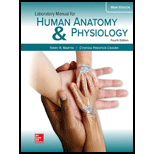
Concept explainers
To explain:
Summary of the visual tests of the persons.
Introduction:
The eye is a three-layered, fluid filled ball divided into two chambers. The sclera forms a white capsule around the eye, except at its anterior surface where it is specialized into clear cornea. The tough, fibrous sclera serves as the insertion point for external muscles that more the eyeballs within their sockets. A portion of the underlying choroid layer is darkly pigmented to absorb light rays at the back of the eyeball. In the front, the choroid layer is specialized into the iris (the structure that gives your eyes their color), the ciliary muscle, and the zonular fibers. Circular and radial smooth muscle fibers of the iris determine the diameter of the pupil, the anterior opening that allows light into the eye. The ciliary muscles determine the shape and focusing power of the crystalline lens just behind the iris. The retina is formed from an extension of the developing brain in fetal life on which the real and inverted image is formed. The eye is divided into two fluid-filled spaces- the aqueous humor between the iris and cornea and vitreous humor between lens and the retina.
The human eye is designed to see both near and far objects. The near point of the human eye is the minimum distance up to which the eye can see clearly without strain. For a healthy human eye, this distance is 25 cm. The far point of the human eye is the maximum distance up to which the eye can see clearly. For a healthy human eye, this distance is infinity.
Want to see the full answer?
Check out a sample textbook solution
Chapter 36 Solutions
Laboratory Manual for Human Anatomy & Physiology Main Version
- Give the resolution of eyepiece, scanning objective, LPO, HPO and OIOarrow_forwardProvide an example of how or whether this vision feedback may be used in a sport/exercise interventionarrow_forwardWhy must the subject hold the Snellen acuity card close to his or her eyes to test near vision?arrow_forward
- Hello, Can you please help me with this question? How would you have responded to engagement prompt #1 that occurred in the recorded webinar? Why? PROMPT #1: NCLEX QUESTION The nurse is testing the extraocular eye movements in a client with complaints of eye fatigue? The nurse would implement which assessment techniques to assess for visual abnormalities and Eye muscle weakness. Select all that apply. Visual Acuity using the Snellen Chart Weber Test Cranial Nerves II, III, IV, VI Cranial Nerve I Refer client to ophthalmologist Thank you in advance!arrow_forwardHypermetropia can be corrected by the use of convex lens. Comment.arrow_forwarddiscussion on obejective lenses: screening, low and high power objectives in whitefish blastulaarrow_forward
- Compute for the total magnification of the following: Ocular Objectives Total Magnification 5x Scanner 5x Low Power 10x Scanner 10x High Power 10x Oil Immersion 15х Scanner 15x Low Power 15x Oil Immersionarrow_forwardWhy is masking of the non-test ear recommended and used in speech audiometric assessment using supra-aural headphones, especially when the client being tested has normal hearing sensitivity? (Hint: What is inter-aural attenuation, and how does this affect the testing paradigm?)arrow_forwardThe basic components of a fluoroscopic x-ray system suitable for interventional procedures consists of a generator,x-ray tube and housing including collimator and filtration,patient table,anti-scatter grid and an image receptor.Describe the key design features and function each of these components and briefly discuss the role of automatic brightness controlarrow_forward
- Understanding Health Insurance: A Guide to Billin...Health & NutritionISBN:9781337679480Author:GREENPublisher:Cengage
 Principles Of Radiographic Imaging: An Art And A ...Health & NutritionISBN:9781337711067Author:Richard R. Carlton, Arlene M. Adler, Vesna BalacPublisher:Cengage Learning
Principles Of Radiographic Imaging: An Art And A ...Health & NutritionISBN:9781337711067Author:Richard R. Carlton, Arlene M. Adler, Vesna BalacPublisher:Cengage Learning - Case Studies In Health Information ManagementBiologyISBN:9781337676908Author:SCHNERINGPublisher:Cengage



